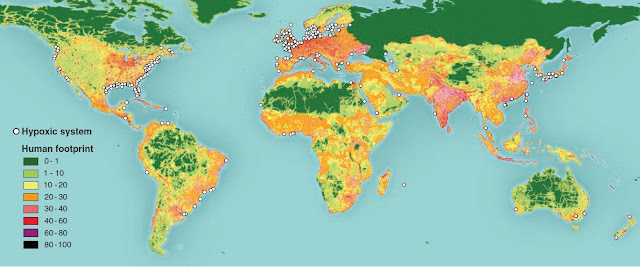 |
| Red Tide La Jolla |
They may look cool but it's not. Where these algae and plankton blooms occur, there is a strange absence of other life. Toxins are generated by the red algae which can kill many species. Not all life is affected, but what is not killed by the toxins actually hold the toxins for some time, making them dangerous for predators, including humans, to eat. Is this all? No, the same thing that helps increase the chances of Red Tides occurring also causes major algae blooms. What's wrong with this, you might ask? The increase in algae also causes an increase in dead material as the algae starts to die. This feeds microbial respiration, which then causes a drop in the oxygen levels. This process is called eutrophication. In extreme algae blooms this can almost completely remove dissolved oxygen from the water, killing most life in the zone, and reducing the habitat available for species, chasing them to other areas in the ocean.
 |
| Redfish Killed by Red Tide by Tony Reisinger |
These dead zones do more than directly kill marine life. Fish and mammal migration through these areas can be impossible, making it difficult for these organisms to move to new food sources. It can also hinder the ability for them to reach breeding grounds, possibly having affect on future generations.
The following is a good talk by coral reef ecologist Jeremy Jackson that discusses biodiversity loss in the oceans. For a focus on Marine dead zones, start at time 9:40 in the video. Dr. Jackson shows some disturbing examples of the effects dead zones have on marine life and other problems they can cause.
According to Diaz et al., 2008 the number of dead zones has doubled each decade since the 1960's. More recent dead zones include the Baltic, Kattegat, Black Sea, Gulf of Mexico and East China Sea. These scientists also note that the worldwide distribution of oxygen depletion is tied to major population centers and watersheds. The following image from the same article shows areas that are hypoxic, or very low in oxygen and it gives an idea of how the zones lacking oxygen relate to population centers. If you could see even closer, the zones also tend to relate to large watersheds.
 |
| Diaz et al. 2008 |
 |
| Hmm.. |
 |
| Howstuffworks image |
What can we do to try and limit or prevent dead zones from occurring? All ideas would need to end in the reduction of nutrients making it to the ocean through waterways. An informative article on Howstuffworks does an interesting job of providing ideas. They note that some scientists feel that the ethanol use in fuel is a major contributor, since the major increase in corn growth requires the use of more nitrogen and other fertilizers to help in the growth. Another thought is that the loss of wetlands around farms also removes a natural filter that cleans out some of the nutrients before they enter the major waterways that are headed to the ocean. For this reason, restoring wetlands could be a long term solution in the reduction of high levels of nutrients and the large blooms of algae in the oceans. In addition to these ideas, limiting the use of nitrogen fertilizers could contribute to the reduction in ocean algae blooms. Recycling the water and minimizing water runoff from crops could contribute to less nutrients running to the oceans. To conserve biodiversity and to protect a fish, a major food supply in the oceans, we must reduce our footprint in the waterways leading to the ocean.
Citations:
No comments:
Post a Comment